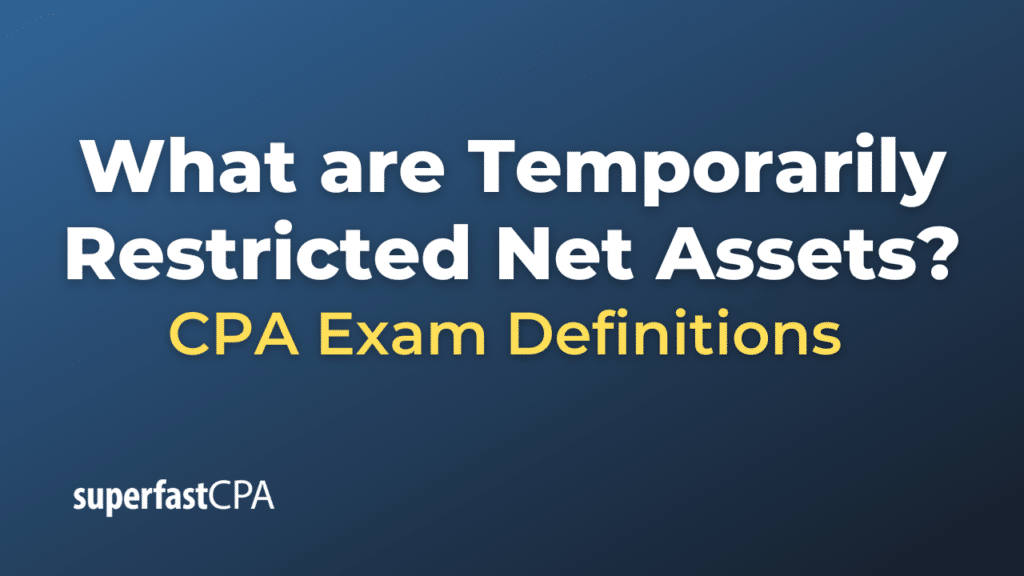Temporarily Restricted Net Assets
Temporarily Restricted Net Assets (often referred to in the context of nonprofit organizations) are resources that are limited in use by donors for either a specific purpose or a specific time period. Unlike permanently restricted assets, where the principal is typically preserved in perpetuity and only the income or earnings can be used (such as an endowment), temporarily restricted assets are designed to be used up or released from their restrictions under certain circumstances or after a certain period.
There are two main types of restrictions that donors can impose:
- Purpose-Restricted: The donor stipulates that the funds should be used for a specific purpose. For example, a donor might give money to a university with the stipulation that it be used solely for scientific research or for a scholarship for students from a particular geographic region.
- Time-Restricted: The donor stipulates that the funds are to be used after a certain date or event has occurred. For example, a donor might give money to a nonprofit with the stipulation that it can’t be used until the next fiscal year or until a specific project begins.
When temporarily restricted funds are either spent for their intended purpose or when the time restriction expires, these funds are “released” from restriction. This means they are reclassified from “temporarily restricted net assets” to “unrestricted net assets.”
In financial reporting for nonprofits, changes in each of these categories (unrestricted, temporarily restricted, and permanently restricted) are often displayed in the Statement of Activities, which is somewhat analogous to the income statement in for-profit accounting. This report allows stakeholders to understand how much of a nonprofit’s resources are readily available for use versus those that are restricted in some manner.
Example of Temporarily Restricted Net Assets
Let’s use a fictional example involving a nonprofit organization named “ClearWater Initiative” which is dedicated to providing clean water solutions in developing countries.
Scenario:
In January 2023, ClearWater Initiative receives the following donations:
- A cash donation of $100,000 with no stipulations. This goes directly into “Unrestricted Net Assets.”
- A cash donation of $50,000 with the stipulation from the donor that the money must be used to build a water purification system in Village A. This is classified as a “Temporarily Restricted Net Asset” because it’s restricted by purpose.
- A cash donation of $30,000 with the stipulation that it can’t be used until 2024. This is classified as a “Temporarily Restricted Net Asset” due to the time restriction.
By December 2023, ClearWater Initiative completes the water purification system in Village A at a total cost of $45,000.
Financial Reporting:
In their Statement of Activities for 2023:
- The initial $100,000 would be added to the “Unrestricted Net Assets” column since there were no restrictions.
- The $50,000 for Village A would initially be reported in the “Temporarily Restricted Net Assets” column.
- The $30,000 time-restricted donation would also be reported in the “Temporarily Restricted Net Assets” column.
By the end of 2023, since the water project in Village A was completed using $45,000 of the designated funds:
- $45,000 would be “released from restriction” and moved from “Temporarily Restricted Net Assets” to “Unrestricted Net Assets” because the funds were used for their intended purpose.
- $5,000 would remain in “Temporarily Restricted Net Assets” to be used for any additional or follow-up expenses related to the Village A project.
- The $30,000 time-restricted donation remains in “Temporarily Restricted Net Assets” and will not be released until 2024.
Thus, ClearWater Initiative’s year-end statement would show an increase in “Unrestricted Net Assets” not only from the unrestricted donation but also from the funds used for the Village A project. It’s essential for nonprofits to track and report these changes transparently, so donors, stakeholders, and other interested parties can see how funds are being utilized and managed.













